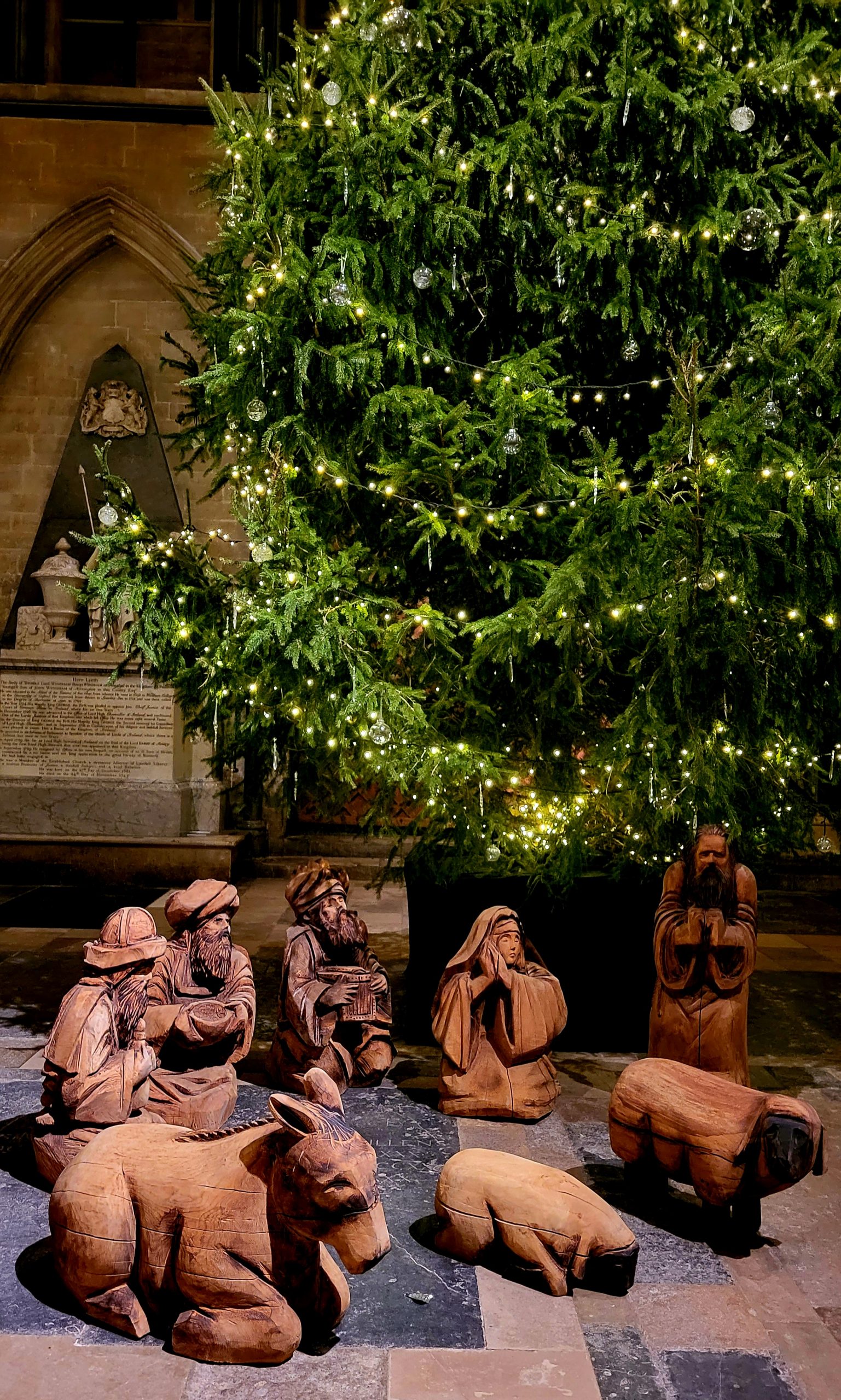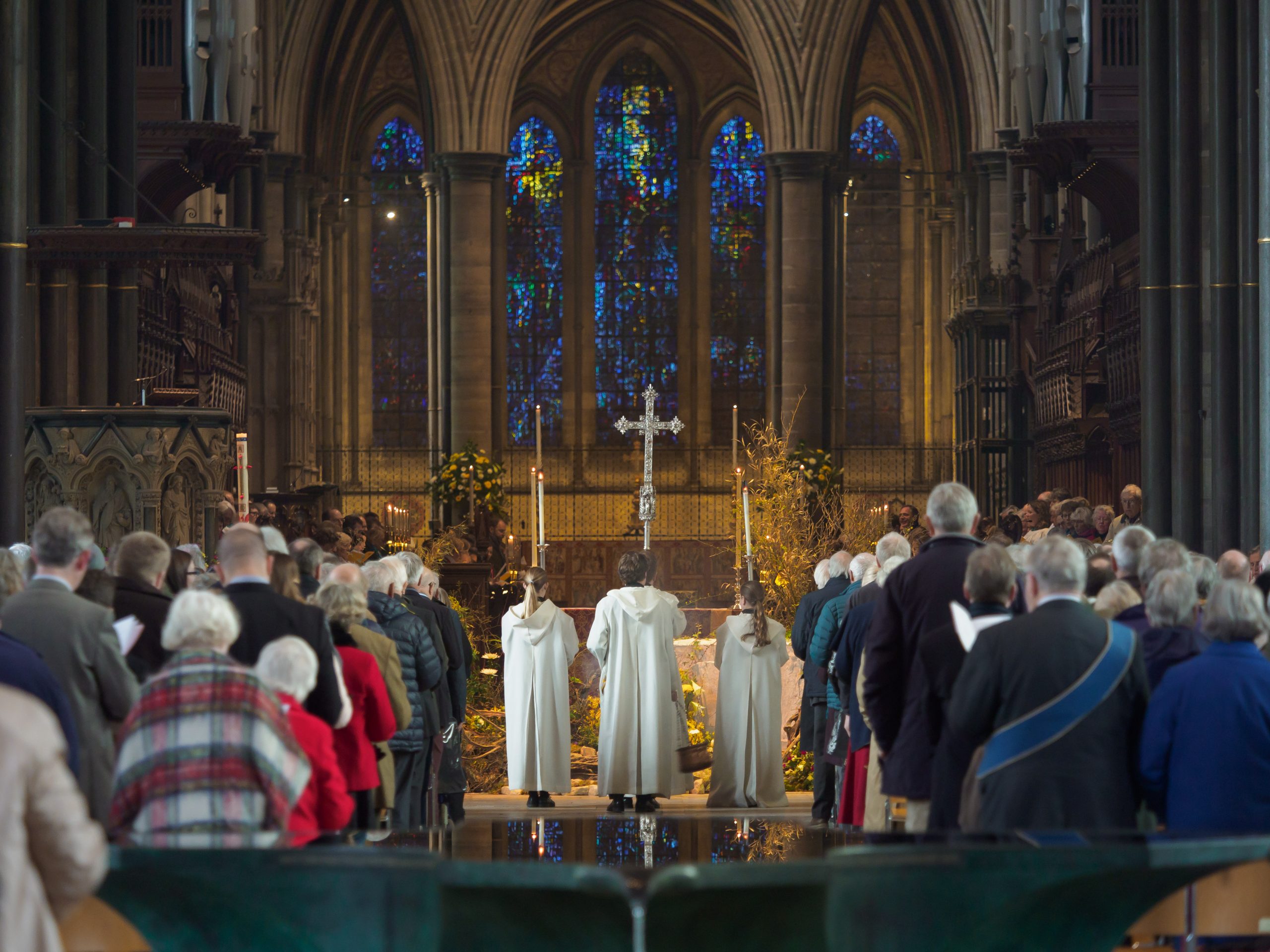The Incarnation and Virgin Birth

A sermon preached by Canon Kenneth Padley, Treasurer.
Sunday 01 January 2023, New Years Day, The Second Sunday of Christmas.
Readings: Galatians 4.4-7; Luke 2.15-21
It is the hard core who attend church on the Sunday after Christmas. It is an even harder core who attend church on the morning after New Year’s Eve. So let’s reward your dedication by digging deep this morning. Together, I’d like us to explore the big doctrine of Christmas, the Incarnation, and its relation to another significant Christian teaching, the Virgin Birth.
The Precentor reminded us two weeks ago that Christmas is popular because it is about story. However, she went on to say that the challenge is to pierce the surface of the narrative and to grapple with the message, in other words with what Christmas tells us about God and salvation.
I was alerted to the need for this a few years ago when a clergyman I know well was asked by his parish primary school to review preparations for their nativity play. The RE-lead teacher laid out plans for a delightful mix of acting and music, readings and prayer. ‘That sound great’, said the Vicar. ‘Just one question: where are you going to tell us about the Incarnation?’ A flash of fear passed across the teacher’s face. ‘What’s that?’, she said.
The tragedy in this story is that the incarnation is what Christmas is all about: it is the point behind the pageantry, the meaning in the manger. The incarnation – literally ‘en-flesh-ment’ – is the belief that, in the one person of Jesus there is a union of two natures, humanity and divinity. It is because of the incarnation that Jesus was (and is) the voice of God speaking to people, speaking the only language we can understand, face to face, as one of us. It is because of the incarnation that Jesus had (and has) both the purity and the humanity to offer a sacrifice for our redemption.
Now, the little-known sentence which we heard at the end of today’s gospel reading, reflects both the human and the divine natures of the child of Bethlehem. Luke 2.21: it is a verse usually snipped off after the narrative of the shepherds and before the tale of Candlemas. It tells us that two things happened eight days after Christmas, both in line with Jewish custom.
Firstly, the baby was irrevocably branded a Hebrew, a member of God’s covenant people – a very physical marker of and in his humanity. To the late medieval mindset (which placed much store on the intensity of Christ’s human suffering), this act provided a unique opportunity for devotion: a series of churches sprang up which claimed the dominical foreskin among their relics. Our colleagues at Wikipedia advise that the last of these was sadly stolen from a church north of Rome in 1983.
The second thing to happen eight days after Christmas was that the baby was given a name. If the circumcision emphasises the baby’s humanity, the name ‘Jesus’ emphasises his divinity: after all, Jesus was the name which Gabriel told to Mary when he announced that her baby would be Son of God.
So, in Luke’s unique record of what happened eight days after the nativity, we see both the human and divine natures shining through the one person of Jesus.
Not all Christians agree about the details of the incarnation, and these differences add colour to the patchwork quilt which is the worldwide Church. The crunch date is AD451. This was when a big Council of bishops met at Chalcedon, just over the Bosphorus from Constantinople. Together, the bishops agreed that the one person of Jesus was to be acknowledged in two natures, without confusion, without mutation, without division, and without separation. The majority of Christians today are members of churches which affirm Chalcedonian Christology. However, there are others, among them some of the most venerable and vulnerable traditions on earth.
Some rejected the Formula of Chalcedon because they had a more unitive understanding Jesus: these became the Coptic Church in Egypt and related Christians in Georgia, Armenia, Syria, and India.
And then there were others at the opposite end of the christological spectrum. These considered Jesus’ two natures to be more distinct than the Chalcedonian formula would allow. They formed what is known as the Church of the East, historically a highly influential but desperately persecuted branch of Christianity.
So where does the Virgin Birth fit into all of this? Well, basically, as a signpost, as a pointer to the incarnation as the great truth of this season. Please bear with me for just a little more clergymansplaining…
The virgin birth is the notion that Jesus’ conception took place not as per the textbook, but as the result of a miracle. All four gospels assert or imply that the earthly origins of Jesus were miraculous. This is a breadth of witness which suggests a widespread belief among Jesus’ earliest followers that his conception was special. Nonetheless, I would encourage you to keep this in perspective, by avoiding two historic grounds which have led to theological overemphasis of the Virgin Birth.
Firstly, the virgin birth became particularly significant to the fourth-fifth century North African bishop, Augustine of Hippo. Saint Augustine believed that original sin was inherited from Adam through sex. Given this, Augustine thought that the Virgin Birth was necessary, necessary to render Jesus free from the taint of original sin, such that he had the appropriate purity to alter our eternal destiny by undoing the mistakes of sinful Adam.
There is of course a problem here, in the form of a bearded biologist called Charles Darwin. The theory of evolution which – contrary to media myth – is accepted by most western Christians, denies Adam to be a historical figure and therefore also destroys Augustine’s idea of sinfulness as sexually contagious. Some sex undoubtedly is sinful, but its sinfulness is to do with non-mutual and abusive relationships and not with the act per se.
There is a second role sometimes erroneously attributed to the virgin birth. Some Christians, often I suspect unconsciously, fuse the virgin birth and incarnation together by thinking that you can’t have one without the other – in other words, that the virgin birth is the mechanism by which God united the two natures in Christ. This line of thinking says that, through the virgin birth, God supplies the bit which would otherwise have come from Joseph. This absolutely cannot be the case. If the second person of the Trinity contributes something to Jesus’ humanity which would otherwise have come from an earthly parent, then Jesus is not fully human. And Jesus must be fully human if he is to speak to us face-to-face, and to bear my sins and yours as an atoning sacrifice on our behalf.
The point of the virgin birth, then, is not to explain how the incarnation happened. Nor, as Augustine thought, is it necessary to salvation. Rather the story of the virgin birth alerts us to the fact that something utterly unique is going on in this particular baby. It is an eye-catcher, an attention-grabber. The virgin birth is telling us to sit up and listen – because God is doing something astonishing in and through this child. That remains his open-ended New Year’s Gift of invitation and hope for the world of 2023.




